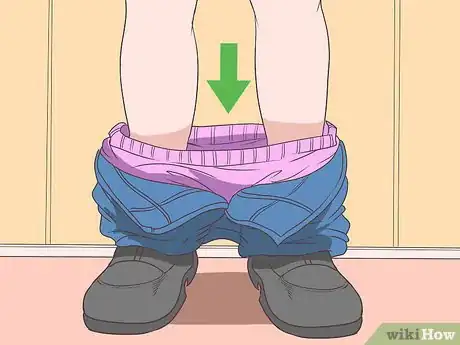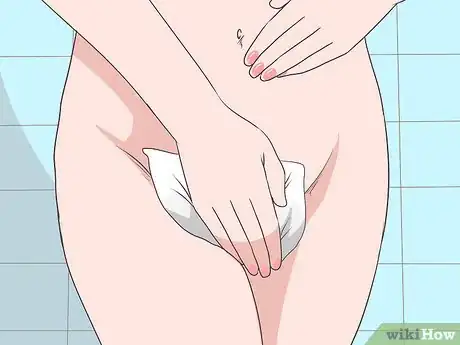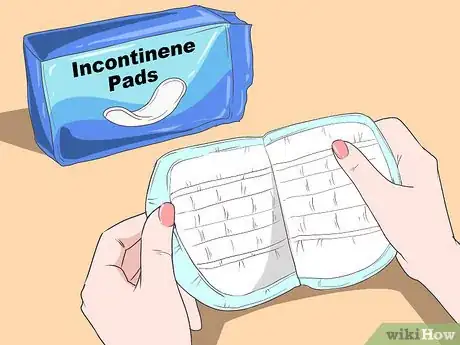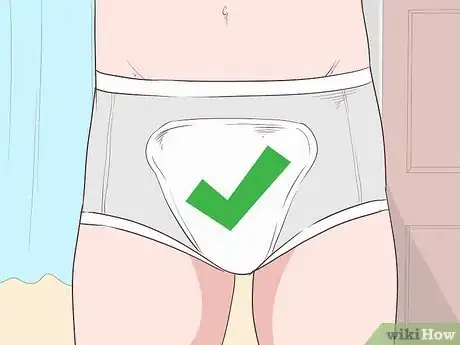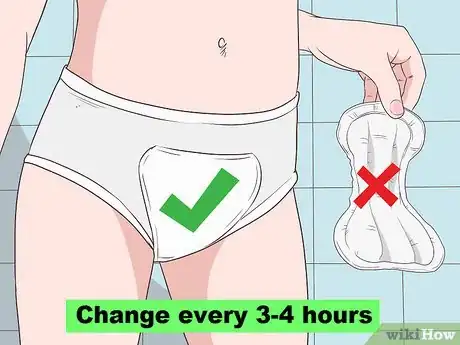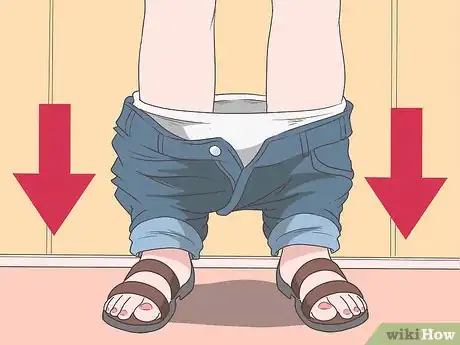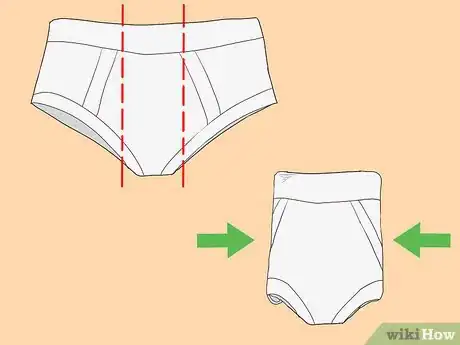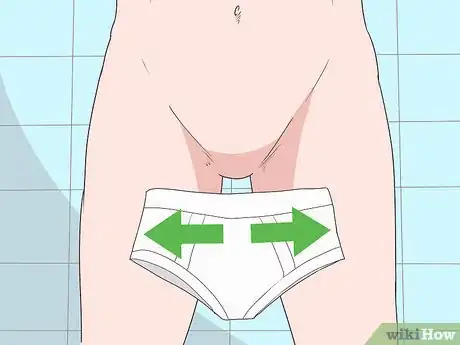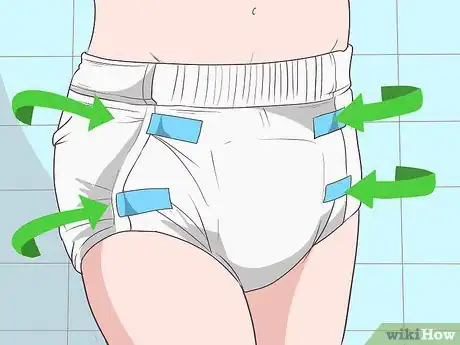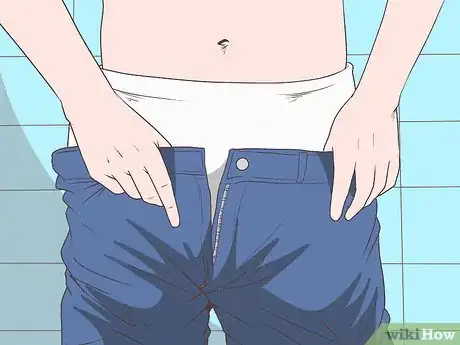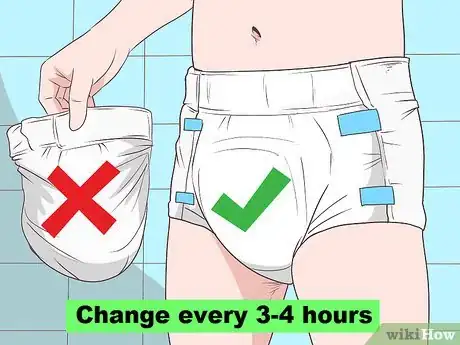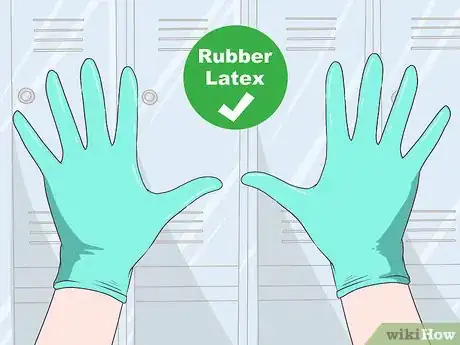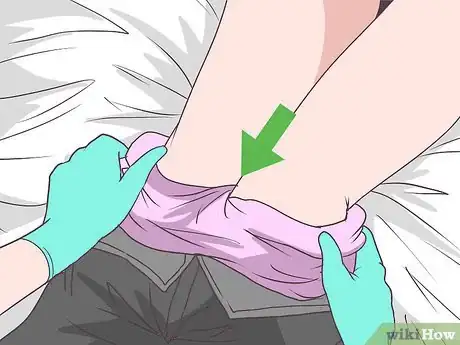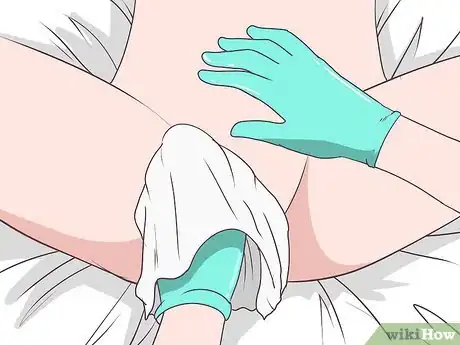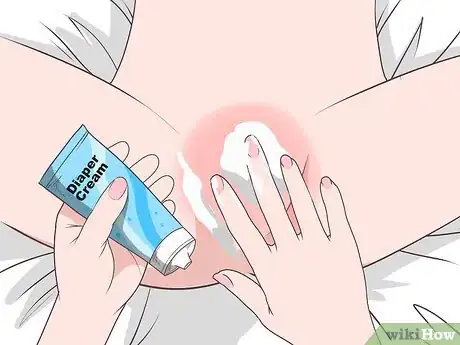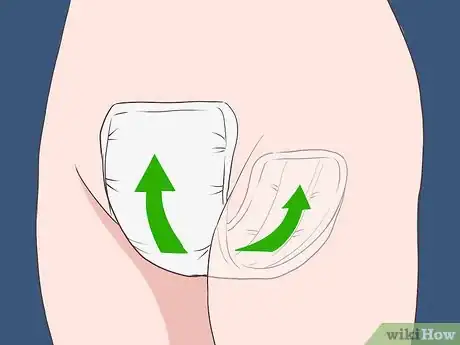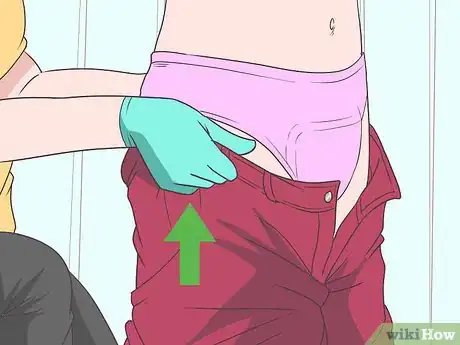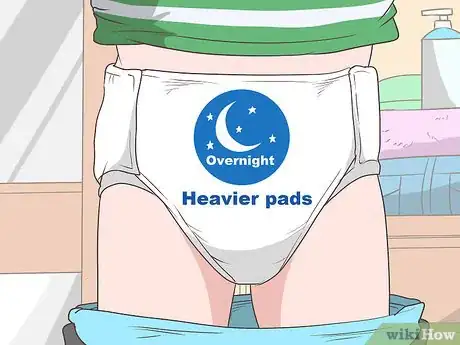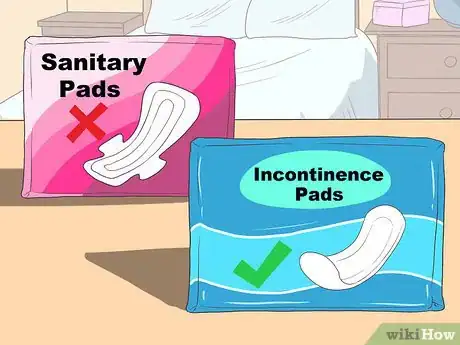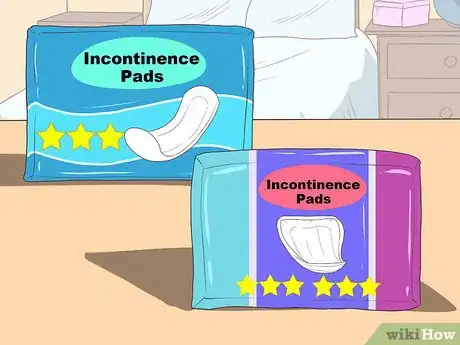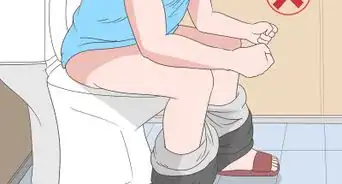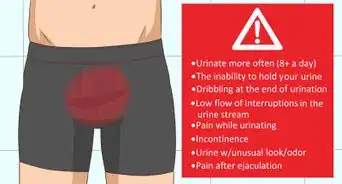This article was medically reviewed by Luba Lee, FNP-BC, MS. Luba Lee, FNP-BC is a Board-Certified Family Nurse Practitioner (FNP) and educator in Tennessee with over a decade of clinical experience. Luba has certifications in Pediatric Advanced Life Support (PALS), Emergency Medicine, Advanced Cardiac Life Support (ACLS), Team Building, and Critical Care Nursing. She received her Master of Science in Nursing (MSN) from the University of Tennessee in 2006.
There are 10 references cited in this article, which can be found at the bottom of the page.
This article has been viewed 55,072 times.
Incontinence pads provide peace of mind while keeping you dry and carefree throughout the day. These pads may come as liners for your underwear or as pull-up briefs. Whichever type you’re using, it is very important to change the pads regularly to keep the skin dry, clean, and healthy. If you’re helping someone else, make sure that they’re comfortable as you apply the pad. If your pads leak, try a different brand or style.
Steps
Inserting Liners
-
1Pull down any clothing to your ankles. Any pants, skirts, and underwear should be pulled all the way down to avoid staining them. If you are wearing a dress, try to hold the dress up out of the way, if possible. If needed, pin the dress up out of the way while you change.
- If your clothing is damp or soaked, replace it with a fresh set. You may want to consider carrying an extra set of clothes to be prepared for these situations.
-
2Wipe the area clean with a moist towelette or damp towel. Clean around your genitals, inner thighs, buttocks, and any other areas that might have urine or feces on them. Pat the area dry afterward with a clean and dry washcloth, paper towel, or toilet paper.
- If you're in a public bathroom without towelettes, just use dry toilet paper. In the future, consider bringing a pack of moist towelettes with you.
- Avoid applying creams to this area when you're using liners. Creams might reduce the effectiveness of liners.
Advertisement -
3Unfold the liner from its package. Smooth out any creases and flatten out the pad with your fingers. This will help prevent discomfort when you wear the liner.
-
4Stick adhesive pads on the bottom of your underwear. Remove the paper covering the adhesive. Place the pad adhesive side down on the seat of your underpants. Press down on both ends of the pad to help it stick.[1]
-
5Pull non-adhesive pads through your legs from front to back. Larger pads may not have an adhesive bottom. Once you insert the pad between your legs, smooth out the front and the back for full coverage. Pull up your underwear around the pad to keep it in place.[2]
-
6Pull your clothing back up. Start by pulling your underwear up, then bring up the rest of your clothing. The pad should now rest snugly between your thighs. It should press against your genitals and buttocks for full coverage.
-
7Replace your liner in 3-4 hours or when it becomes soaked. Leaving on a wet liner for too long can cause rashes or soreness. Change your liner when it becomes noticeably wet. If it’s not wet, change it after 3-4 hours. Most people go through 4-6 pads a day.
- Never reuse a wet pad. Always dispose of soiled pads.
- Some brands may have a “wetness indicator” that will fade or change color when it is time to change your pad. Read the package of your pads for more information.
- Remember that the best way to prevent skin irritation is to keep the skin clean and dry. This requires checking the liner often and changing it as soon as it becomes soiled.
Using Belted Briefs
-
1Push clothing out of the way. Drop your pants, skirt, and underwear down all the way to your ankles. If you’re wearing a dress, hold or pin the dress up above your waist to keep it out of the way.
-
2Clean the area using a moist towelette or a damp paper towel. If possible, do this over a toilet to catch any leaks. Wipe any area that touches the brief or pad. Pat it dry afterwards.[3]
- If you get irritation from wearing the briefs, apply diaper cream or barrier cream over the areas that touch your briefs.
- Get in the habit of carrying moist towelettes with you. You can pull these out in public restrooms to clean yourself if you need to change.
- Make sure your skin is completely dry before you put on a belted brief.
-
3Fold the briefs in half length-wise. Folding up the brief will ensure that it goes on correctly and absorbs effectively. Fold it so that the absorbing liner is on the inside.[4]
-
4Insert the brief between the legs from front to back. Keep your feet slightly apart as you insert the brief. The seat of the brief should sit between your thighs. The tabs should rise around your waist. Once between your legs, open up the folded brief so that it cups your genitals.[5]
-
5Attach the front and back tabs together. Incontinence pads usually have 4 adhesive tabs, 2 from the left and 2 from the right. Pull the tab over to the other side of the brief and press down to adhere. Once the first side is secure, repeat the process on the other side.
- Some tabs may have a paper backing over the adhesive on each tab. Remove this before securing the briefs. Other pads may use velcro to attach the briefs. In this case, you don't need to remove anything.
-
6Replace your clothing. Some belted briefs may not need underwear, but you can still put a pair of underwear over the briefs if you choose. Dress as normal.
-
7Change your briefs every 3-4 hours or when it becomes soaked. If the briefs feel wet or if they’re leaking, replace them with a fresh pair. If it’s not wet, change it after 3-4 hours. Throw away briefs after you have used them. You may go through 4-6 briefs a day.
- Some brands may have a “wetness indicator” that will show when you need to change your briefs. Read the package for more information.
Helping Someone Else
-
1Put on disposable rubber or latex gloves. When applying incontinence pads for someone else, you may come into contact with urine, feces, or other bodily fluids. To protect your hands, wash them with soap and water before putting on gloves.[6]
- You can buy gloves at grocery stores, convenience stores, or pharmacies.
-
2Remove the person’s pants and underwear. Pull down their pants, skirt, and underwear. If they are wearing a dress, ask them to hold the dress up above their waist as you assist them.
- If their underwear is soiled or wet, make sure to remove them entirely and replace them with a fresh pair.
-
3Clean the area around their genitals. Use a moist wipe or damp paper towel to gently remove any visible urine or feces. Make sure to check the folds near the genitals and the inner thighs. Use a towel or dry paper towel to pat the area dry when you are finished.
-
4Apply a barrier cream around their genitals if using briefs. A diaper cream or barrier cream can help prevent rashes and discomfort. Rub the cream into the skin on the inner thighs, buttocks, and any place the brief might touch.[7]
-
5Insert the liner or briefs between their thighs from front to back. Ask the person to move their feet slightly apart. Fold the liner or brief in half like a hot dog bun to make it easier to insert. If the person is bedbound, roll them over to their side. Ask their doctor or nurse to show you how to safely roll them.[8]
- If the person is wearing an adhesive liner, pull off the paper backing. Press the adhesive liner down into the seat of their underwear.
- If the person wears a non-adhesive liner, insert it between their legs from front to back. Pull up their underwear to keep it secure.
- If the person is using belted briefs, pull over each set of tape to the other side of the brief. Press down for a few seconds until it holds.
-
6Pull up their clothing again. Bring their underwear securely up to their waist. Help the person pull their pants or skirt back up.
-
7Throw away the gloves before washing your hands. Even if you wore gloves, it’s always a good idea to wash your hands after helping someone apply incontinence pads.
Avoiding Leaks
-
1Use heavier pads overnight. Since you’ll be wearing the pad all night time, get a heavier, more absorptive pad for sleeping. Look for pads marked as “overnight” or “sleeping” pads.[9]
-
2Buy incontinence pads instead of sanitary pads. While sanitary pads might be cheaper, they usually don’t work as well for incontinence. Make sure that you’re getting pads that are marked as incontinence pads.[10]
-
3Try a different brand if your current brand isn’t working. While many brands use terms like “Super” or “Plus,” there is no standard for how much a pad can absorb. If you’re going through pads quickly, try buying a different brand to see if they work better.[11]
Warnings
- If you notice any severe rashes, broken skin, or wounds, contact a doctor as soon as possible.⧼thumbs_response⧽
- People in wheelchairs should reposition themselves every 15 minutes.⧼thumbs_response⧽
- Keep the skin as dry as possible around your genitals and buttocks. Moist skin is more likely to develop rashes or wounds.⧼thumbs_response⧽
- Keep in mind that incontinence pads may cause pressure ulcers or bedsores if urine and feces come in contact with the skin for a prolonged period. Reposition the person often to increase their blood circulation. Staying in one position for too long will increase the risk of the person developing bedsores. Check the pads frequently to know if it is soaked already.⧼thumbs_response⧽
- Make sure to reposition bedridden individuals every 2 hours.⧼thumbs_response⧽
References
- ↑ https://www.youtube.com/watch?v=7jTKOdqpLGU&feature=youtu.be&t=137
- ↑ https://www.youtube.com/watch?v=7jTKOdqpLGU&feature=youtu.be&t=347
- ↑ https://woundcareadvisor.com/how-to-manage-incontinence-associated-dermatitis/
- ↑ https://www.youtube.com/watch?v=7jTKOdqpLGU&feature=youtu.be&t=526
- ↑ https://www.youtube.com/watch?v=7jTKOdqpLGU&feature=youtu.be&t=560
- ↑ https://www.continence.org.au/pages/continence-products.html
- ↑ https://www.continence.org.au/pages/continence-products.html
- ↑ https://www.youtube.com/watch?v=7jTKOdqpLGU&feature=youtu.be&t=560
- ↑ https://www.continence.org.au/pages/continence-products.html
